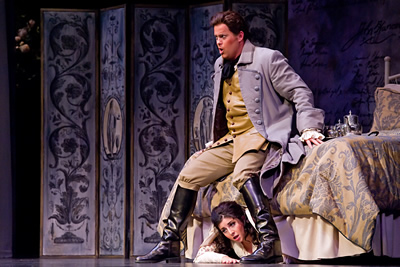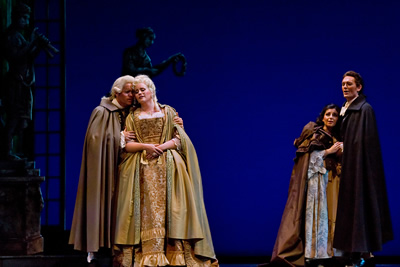Michigan Opera Theater Performs
Mozart’s Marriage of Figaro
by Jennifer Burns
December 2011
The Marriage of Figaro
An opera by Wolfgang A. Mozart
Libretto by Lorenzo da Ponte
Michigan Opera Theater (MOT)
Detroit, Michigan
November 2011
Conductor: Kazem Abdullah
Director: Mario Corradi
|
Photo by John Grigaitis, Michigan Opera Theater..
|
The Michigan Opera Theater’s November 2011 production of Mozart’s 1786 opera, The Marriage of Figaro, was superb from beginning to end. The conductor, Kazem Abdullah was successful in bringing out even the smallest ironies embedded in the opera, thus bringing the polyphony to the fore of the mind of the audience. It conveyed a real respect for Mozart’s and Da Ponte’s intent to expose the oligarchical mindset, and teach the population how to defeat that oligarchy. Mozart’s humor radiated throughout as each singer ridiculed the oligarchs, proving that when a group of performers really are engaged in the performance, the idea developed by them is bigger than the singing and acting of each singer. (The whole is actually greater than the sum of its parts.)
The plot of “Figaro” itself is complex, and was based on American Revolution financier and supporter Pierre Caron de Beaumarchais’s French language trilogy (The Barber of Seville, The Marriage of Figaro and The Guilty Mother.) Mozart insisted to Da Ponte that he wanted to produce this particular work as an Italian opera, and their creation revolutionized opera. Not only was the plot about two servants outsmarting their oligarchic noble boss’s various plans—a very touchy issue in the Europe of 1786—but it was well known in Mozart’s time that the Emperor had forbidden the play from being performed, as it was too revolutionary. After many attempts to block or sabotage its performance, the new opera was performed in 1786, with this introduction:
This opera will not be one of the shortest to have been exhibited in our theater, for which we hope that ample recompense will be offered by the variety of themes woven into the action of this play, as well as its originality and large dimensions. The musical numbers are of the widest possible variety, so as not to leave any performers unoccupied for long periods, to avoid the tedium and monotony of long recitatives, and to lend expression to the many different passions which the characters experience. We wanted to present our most gracious and honorable public with a virtually new kind of play.
|
Photo by John Grigaitis, Michigan Opera Theater..
|
In this MOT production, although others strongly disagree, I personally liked the addition of the backdrop setting, onstage throughout the performance, which was a huge image of the American Declaration of Independence and the Detroit Declaration (joining the Union). If the “Idea of 1776”, which is implicit in the Marriage of Figaro, was not evident enough, as it should be through the music and poetry, it is made explicit here.
Too often, directors of operas or other musical masterpieces will make their own interpretations which are quite different from the composers’ intentions. The famous conductor Wilhelm Furtwängler elaborated the awesome task of the performer or conductor—to be able to truthfully represent the intent of the great composers, without imposing their own ideas, in his essay “Principles of Interpretation:”
He found himself holding in his hands a treasure of incalculable value- the whole of the past- with no higher authority to which to appeal for help. This moment marked the beginning of the ludicrous overestimation to which he himself had tended from the outset, alone as a result of perpetually confronting the public. But it also marked the onset of a move to escape from his power, to restrict his influence, to lay down the path he should follow, to check his activities at every possible turn.
|
Photo by John Grigaitis, Michigan Opera Theater..
|
The score of the Marriage of Figaro, (“the incalculable treasure”), must humble the great conductor, director and performer, to successfully convey what Mozart composed, and I think this production succeeded. When the beauty of the bel-canto singer’s voice functions as the instrument of a higher idea, rather than an opportunity to show off technique and vocal prowess, the entire room is shaped by that idea, and the “composer’s voice” can be “heard.”
The voices of the Countess (Rachel Willis-Sorensen, soprano), Count Almaviva (Corey McKern, baritone), Susanna, (Grazia Doronzio, soprano), and Figaro (Jason Hardy, bass), were all strong and well matched, which was very important, because Mozart’s numerous ensembles require that each voice be heard individually at the same time that the “One” idea of the ensemble is also heard as they sing together. In solo arias as well, including Cherubino, (Lauren McNeese, mezzo-soprano), the performers captivated the audience with a clear desire to get across Mozart’s idea.


 View full size
View full size View full size
View full size